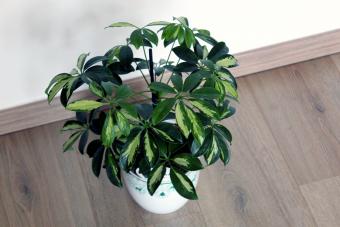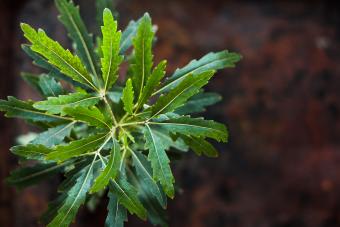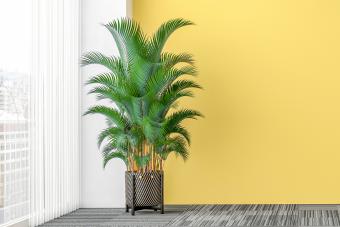
If you're looking to spruce up your home with some sizeable houseplants, an indoor tree is just what the plant doctor ordered. Nothing brightens up a living space like a few carefully selected and placed trees. Some of the best options for indoor trees add lush color and dramatic foliage, and a few even bear fruit or bring luck.
Choose One of the Best Indoor Trees to Beautify Your Home

These 15 trees will add beauty to your home. From fragrant and colorful citrus trees to tropical palms, with the right water and lighting conditions, these trees will thrive indoors and fill your house with vibrant, living art.
Areca Palm

Areca palms (Dypsis lutescens), also often called bamboo palms, are frondy indoor trees that reach up to seven feet tall when fully mature. They require bright, indirect sunlight. They can do well in lower light temporarily, but will only thrive indoors when they regularly get bright, filtered light. You'll need to water regularly to keep the soil moist (but not soggy). Just add water when the soil becomes dry to the touch.
Areca palms make a great houseplant because they're not toxic to pets, according to the ASPCA.
Braided Money Tree

Braided money trees (Pachira aquatica) are also terrific indoor trees for sunny areas. Also called Malabar chestnuts, these trees are known for their distinctive braided trunks. Money trees usually reach between four and six feet tall when grown indoors. Because braided money trees have relatively long trunks, you may need to provide stakes to support their growth. This plant's soil needs to dry out between waterings, so don't add water while it is still moist.
In feng shui, money trees are believed to promote prosperity, especially when placed in the wealth corner of your home or business.
Calamondin Orange Tree

Grow oranges indoors? Sure you can! As long as you have space in a very sunny window, a Calamondin orange tree (Citrus x citrofortunella mitis) will provide beauty and fresh citrus fruit. Often called a miniature orange tree, this plant tree is a cross between a mandarin orange and a kumquat tree. The fruit is orange, but it tastes more like a lemon. These trees typically don't exceed three feet tall when grown indoors. They need consistent moisture, so water as soon as the top of the soil gets dry.
If you want your Calamondin orange trees (or any citrus trees) to grow fruit indoors, then the tree needs to be at least be three years old. Unless you want to release bees in your house (yikes!), you'll need to hand pollinate them. Use a clean paintbrush to pull pollen from the flowers and deposit it on other blossoms.
Corn Plant

Corn plants (Dracaena fragrans) are small evergreen trees that are very easy to care for as houseplants. These plants thrive in moderate and even low-light conditions. Even bright light is fine as long as it's well filtered and minimal, as too much bright light can scorch this plant. Corn plants can reach up to six feet tall indoors. It's important to let them dry out between waterings. Under watering is better than over watering.
Corn plants are super easy to grow and may even thrive on a little (but not too much) neglect. This is because they prefer to be under watered to over watered, making it an easy-care plant for people who often forget to tend to their houseplants.
Dragon Tree

Looking for an indoor tree that's as gorgeous as it is low maintenance? If so, a dragon tree (Dracaena marginata) - also known as red-edged dracaena - just might be the houseplant of your dreams. These trees love bright, indirect sunlight, so they'll thrive near a sunny window in your home. It's easy to know when to water a dragon plant - just watch for the top layer of soil to dry out, then add water. They can reach up to eight feet tall indoors.
Dragon trees are great clean-air plants, removing formaldehyde from the air in your home, according to NASA's plants and indoor air quality study.
Dwarf Olive Tree

If you have a sunny area in your home that's in need of a tree, a dwarf olive tree (Olea europaea 'Dwarf Olive') might be perfect. Just don't expect it to produce olives - even fruiting varieties don't fruit when grown indoors. These trees can reach about five feet tall when grown inside. Avoid over watering by adding water only when the top few inches of soil are dry. When it's warm outside, take your tree outdoors for a while to give it some sunshine.
If you've ever heard the term "extend the olive branch," then you might not be surprised to know that an olive tree represents peace. An indoor dwarf olive tree makes a great "I'm sorry" present for a plant-loving pal.
Dwarf Umbrella Tree

Dwarf umbrella trees (Schefflera arboricola) are small, multi-trunk trees that typically don't grow taller indoors than four feet. They are shrub-like in appearance when they are small, but they lose their lower leaves as they grow to take on a more traditional tree shape. When grown indoors, these trees do best in bright, indirect light, but they will also tolerate and do fine in moderate light. They can even handle some direct light.
When umbrella trees grow outdoors, they are flowering plants, but they seldom blossom indoors. Because the plants are mildly toxic to pets and humans, keep them out of reach of tiny paws and hands.
False Aralia

False aralia (Schefflera elegantissima) thrives in moderate light, as well as bright light conditions in which it's protected against direct sunlight. Temperature is important for this plant; keep false aralia in a space that doesn't dip below 60°F. This small tree has a bushy habit. It can grow to six feet tall indoors. It needs consistent moisture, so you should water it whenever the top inch of the soil becomes dry.
Once you find a spot where your false aralia thrives, it's best to keep it there. False aralia hates moving... any sudden moves can cause leaf drop. So, if you do need to move locations, you may want to find a way to move it gradually to its new spot. Better yet, keep it where it is, and it will be a happy plant.
Fiddle Leaf Fig

If you're looking for a tall focal point plant for a room that has a high ceiling, a fiddle leaf fig (Ficus lyrata) is a great option. This lovely plant can grow to reach 10 feet tall indoors, making it a wonderful selection for a room that has a vaulted ceiling. Fiddle leaf figs need at least six hours of bright indirect sunlight each day (or the equivalent via a grow light) in order to stay healthy and keep their leaves. These plants should be watered as soon as the top inch of soil dries out.
Fiddle leaf figs can fruit, but only when they grow outdoors and in the right conditions. They require the proper temps and fig wasps for pollination. Since wasps aren't an ideal housemate, fiddle leaf figs grown indoors won't fruit. But, with proper care, they can live a very long life - 25 to 50 years in some cases.
Fishtail Palm

Fishtail palms (Caryota) prefer bright, indirect light, but they will also do well in medium-light conditions. If the sunniest window in your home already has a tree in it, but you want to add more (who knew that houseplants were so addictive?), you can place this type of tree in an area that gets a bit less light. They generally grow to reach around six feet tall indoors, but can even grow taller in ideal conditions. Fishtail palms need to be watered when the top two inches of soil become dry.
Fishtail palms in outdoor conditions will flower and bear fruit, but it's unlikely indoors. That's not a bad thing if you want a long-lived houseplant, because once a fishtail palm bears fruit, the trunk that grew it will die. If it does bear fruit, the fruit is edible, but because the flesh contains oxalic acid, it stings. Keep the plants away from pets and kids. It's toxic to both.
Kentia Palm

Kentia palms (Howea forsteriana) are also a great choice for houseplant enthusiasts who don't have a sunny window to spare. Unlike most types of palm trees, kentia palms do great in moderate to low light conditions. These lovely trees can reach up to 10 feet tall indoors, so they're ideal for rooms with vaulted or high ceilings. Add water when the top inch of soil has dried out.
The kentia palm is one of the first palms to be cultivated as a houseplant. It's native to Lord Howe Island in Australia. You may also see it called a sentry palm or paradise palm.
Meyer Lemon Tree

Love citrus? Add a Meyer lemon (Citrus × meyeri) tree somewhere in your home that gets 8-12 hours of bright, ideally direct (no curtain or sheer), light (or the equivalent of artificial light from a grow light). With enough light, these trees will produce fruit indoors. Standard Meyer lemons can grow to six feet tall inside, while dwarf varieties tend to stay under four feet. Water as soon as the top inch of soil no longer feels damp.
As with other citrus trees grown as indoor plants, the Meyer lemon requires hand pollination of its blossoms to bear fruit. Meyer lemons are fragrant, slightly sweet, vibrantly flavored lemons that make delicious lemonade, are great in lemon meringue pie, and make a mighty fine cocktail.
Norfolk Island Pine

You'll need a sunny window that lets in a lot of light to grow a Norfolk Island pine (Araucaria heterophylla). These small trees typically stay between three and eight feet tall indoors. They need to be watered as soon as the surface of the soil starts to feel dry to the touch. They also need humidity, so it's a good idea to put a saucer full of pebbles under the tree's container.
Despite their name, Norfolk Island pines aren't actually pine trees, though they are conifers. NASA's clean air houseplant study showed that Norfolk Island pines are great for removing harmful volatile organic compounds (VOCs) from the air in your home.
Parlor Palm

Looking for a small tree for a moderate-light or low-light part of your home (or even an area with limited bright light)? Look no further than the parlor palm (Chamaedorea elegans). This single-trunk palm tree tends to stand between two and four feet tall, though in a large enough pot, it can grow up to six feet tall. It's important to avoid over watering parlor palms. You should wait until the top few inches of soil in the container are dry before watering this plant.
Parlor palms are extremely slow-growing plants, so it can take a few years for them to outgrow their pots. Repotting is only required every three years or so, even in ideal indoor growing conditions.
Rubber Tree Plant

Rubber tree plants (Ficus elastic) need bright, indirect light, but they shouldn't be exposed to too much heat. Rather than placing this type of tree in a sunroom or in front of an uncovered window, it would be best to put it in front of a sunny window that's covered by a sheer window treatment. Rubber tree plants can reach up to six feet in height. Add water as soon as the soil becomes dry to the touch, as these plants need steady moisture.
Wondering why it's called a rubber tree plant? When they are about six to seven years old, rubber tree plants produce a milky white sap called latex that's used to produce natural rubber.
Keys to Indoor Tree Growing Success
Keeping indoor trees healthy does require some maintenance, but their beauty and air-purifying benefits are well worth the effort. Whatever indoor trees you choose, you'll need to plant them in well-draining soil or potting mix, then fertilize them during their growing season with a plant food designed for indoor plants. You'll also need to periodically (every few years) re-pot them into larger containers. This will help keep them from becoming rootbound in pots they have outgrown. You'll also want to periodically trim damaged leaves to keep your indoor trees looking fresh and beautiful. With wise plant selection and a bit of TLC, your indoor trees will beautify your home for many years to come.







